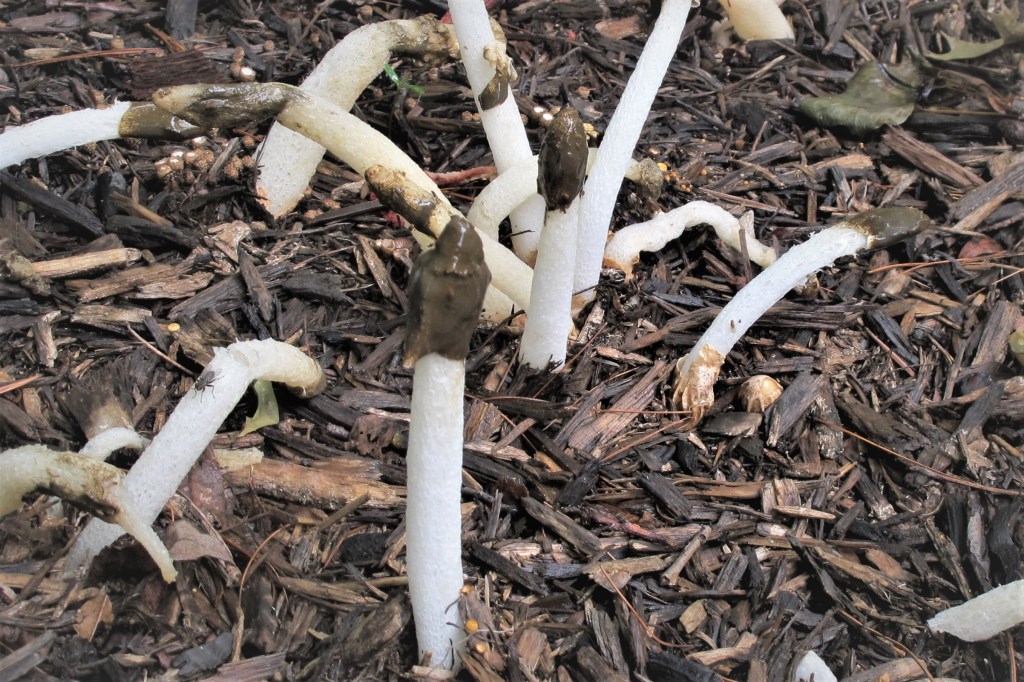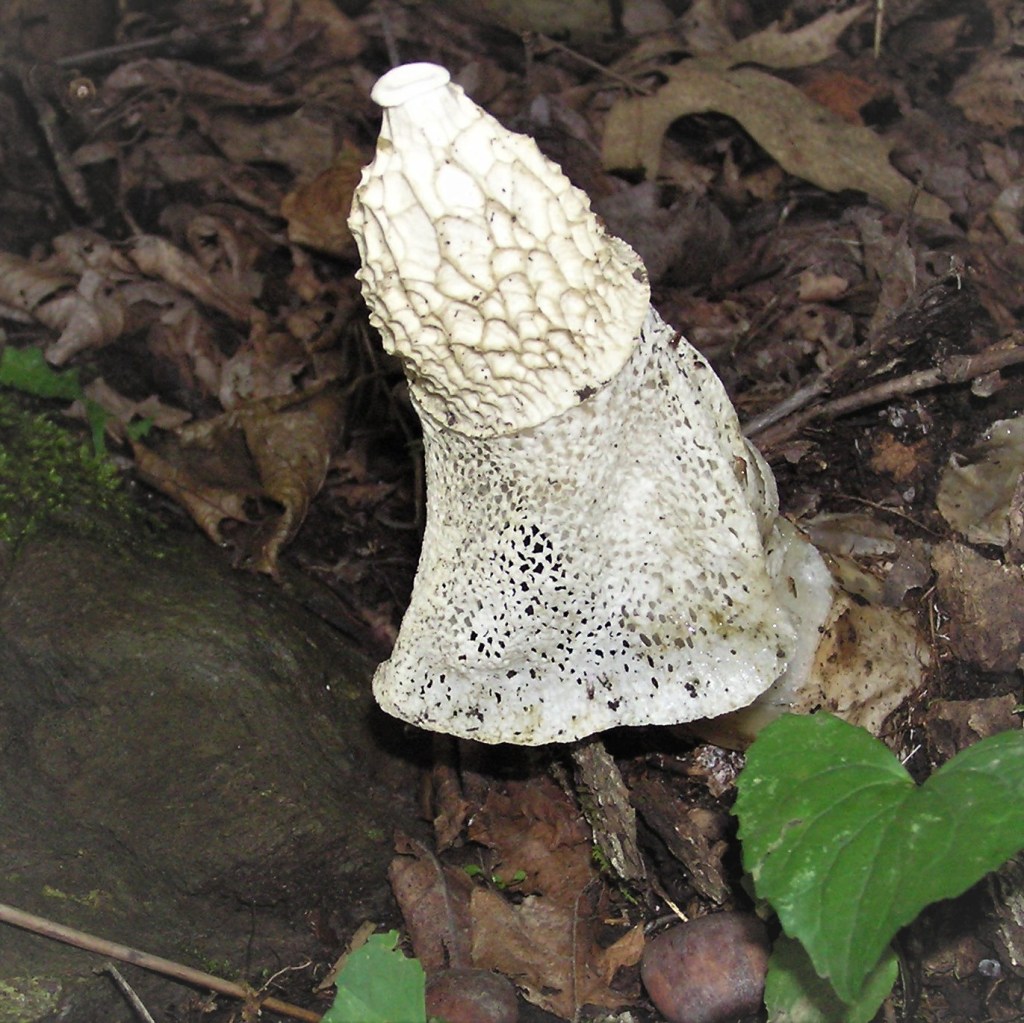
Common Name: Stinkhorn, Carrion fungus – Stink can mean either emitting a strong, offensive odor or, ethically, to be offensive to morality or good taste. Both interpretations apply according to the context herein. Horn is a foundational word of the Indo-European languages that refers to the bony protuberances that adorn the heads of many ungulates like deer. In that it also is associated with supernatural beings like the devil, it may be that this connotation was the original intent for its use. Devil’s dipstick is an idiomatic name for some species of stinkhorn that suggest this interpretation.
Scientific Name: Phallaceae – Phallus is the Greek word for penis. There can be no doubt that the family name was selected due to verisimilitude, the remarkable resemblance of the stinkhorn to male, mammalian, and notably human anatomy.

Potpourri: Stinkhorns are a contradiction in terms. For some they are the most execrable of all fungi and for others they are elegant, one species even being so named (see Mutinus elegans). They range in size and shape from the very embodiment of an erect male canine (M. caninus named for its resemblance to a dog penis) or human penis (like Phallus ravenelii in above photograph) to colorful raylike extensions ranging outward and upward like a beckoning, stinking squid (picture at right). In every case they are testimony to the creativity of the natural forces of evolution, seeking new ways to survive the rigors of competition. Like the orchids that extend in intricate folds and colors of “intelligent design” to attract one particular insect to carry out pollinator duties, stinkhorns have become “endless forms most beautiful and most wonderful” that defy the odds of probability that must therefore lead to evolution as an explanation. [1] The priapic and tentacled extensions can only have been the result of successful propagation for the survival of the species, just like Homo erectus.
The phallic appearance of some stinkhorns is not as outré as it seems at first blush. The priapic shaft elevates spores to promote dissemination. Like a fungal Occam’s razor, stinkhorns evolved the simplest solution―growth straight upward with no side branches, placing the spore gleba at the bulbous apex. The fungus accomplishes this in a manner similar to humans, using water pressure to hold the shaft erect in lieu of blood pressure; hydrostatic versus hemostatic. The phenomenon is part of the fungal life cycle that starts in the mycelium, the underground tangled mass of threadlike hyphae that is the “real fungus.” The stinkhorn starts in the mycelium as an egg-shaped structure called a primordium containing the erectable shaft surrounded by spore laden gleba held firmly in place with jellied filler cloaked with a cuticle. It is the fruiting body of the fungus. When environmental conditions dictate, the “egg hatches,” and the water pressurized shaft grows outward and upward lubricated by the jelly at a rate of about five inches an hour until it reaches fly over country. Here the biochemistry of smells including hydrogen sulfide (rotten eggs), mercaptan (rotting cabbage), and some unique compounds aptly named phallic acids draws flies from near and far. In ideal conditions, the slime and spores will all be gone in a few hours, and the bare-headed implement of reproduction will soon become flaccid.
Stinkhorns belong to a diverse and now obsolescent group of fungi called Gasteromycetes from gaster, Greek for “belly” and mykes, Greek for fungus. With the translated common name stomach fungi, they are characterized by the enclosure of their spores inside an egg-shaped mass called a gleba (Latin for “clod”). Hymenomycetes alternatively have their spores arrayed along a surface called a hymenium (Greek for “membrane”) and are by far the larger grouping. The hymenium surface can take the form of gills or pores on the underside of mushroom caps or any of a wide range of other shapes ranging from the fingers of coral fungi to the cups of tree ear fungi. The Gasteromycetes include puffballs and bird’s nest fungi. [2] In the former, the ball of the puffball is the gleba. On aging, a hole called an operculum forms at the top so that the spores can be ejected (puffed) by the action of falling raindrops for wind dispersal. Each “egg” in the bird’s nest is a gleba and is also forced out by the action of falling rain. The projectile gleba affixes to an adjacent surface from which spores are then also air dispersed. Stinkhorns evolved to distribute the spores from the gleba following a completely different evolutionary random sequence. They attract insects to the stink at the top of the horn.
Flowering plants called Angiosperms are ubiquitous, successful in their partnership with many insects to carry out the crucial task of pollination. While this is primarily a matter of attracting bees and bugs with colorful floral displays and tantalizing scents promising nectar rewards, there are odoriferous variants. Skunk cabbage earned its descriptive name from the fetid aroma that attracts pollinating flies to jumpstart spring with winter’s snow still on the ground. Another member of the Arum Family, the cuckoopint, attracts flies with its smell and then entraps them with a slippery, cup-shaped structure embedded with downward pointing spines, releasing them only at night after they are coated with pollen to then transport. Stinkhorns produce an olfactory gelatinous slime containing its reproductive spores that some insects, mostly flies, are drawn to. It is not clearly established whether the flies eat the goo and later defecate the spores with their frass [3] or whether they are only attracted by the smell, perform a cursory inspection, and then fly off with spores that “adhere to the bodies of the insects and are dispersed by them.” [4] Some insight can be gained according to entomology, the study of insects. Do they eat the slime or do they merely wallow in it?
The primary insects attracted to stinkhorn fungi are the blow flies of the Calliphoridae Family and the flesh flies of the Sarcophagidae Family. The term blow fly has an interesting etymology that originates with their characteristic trait of laying eggs on meat that hatch into maggots, the common name for fly larva. Any piece of meat left uncovered in the open long enough for the fly eggs to hatch was once called flyblown, which gradually took on the general meaning of anything tainted. The reversal of the festering meat term gave rise to the term blow fly for its cause. As a purposeful digression, wounded soldiers in the First World War left unattended for hours on the battlefield were sometimes found to be free of the infections that plagued those treated immediately because the blow fly maggots consumed their necrotic tissue. It is now established the maggots also secrete a wound healing chemical called allantoin (probably to ward off competing bacteria) and they are sometimes intentionally used to treat difficult infections. Flesh flies, as the family name suggests (Sarcophagidae means flesh eating in Greek), are also drawn to carrion to eggs for their larvae to eat. [5] If blow flies and flesh flies are attracted to stinkhorns due to the smell of rotting meat, they would presumably lay eggs. So the conundrum is what happened to the maggots? While eggs could hatch in a few days and larvae would feed for a week or two, stinkhorns last for several days, their slime removed in half that time.
Field experiments have verified that stinkhorn fungal spores are indeed ingested by flies. Drosophila, the celebrated fruit fly of early genetic studies, had over 200,000 stinkhorn spores in their intestine when dissected in an experiment. Given the volume available in a fruit fly gut, this quantity adds some perspective to the vanishingly small size of spores. The larger blow flies were found to contain more than a million and a half spores in a similar field evaluation. It was further demonstrated that spores passing through insects and defecated in their frass were fully functional. [6] This is not too surprising as spores evolved for survival under hot, cold, or desiccated environmental extremes; the fly gut is relatively benign by comparison. It is true, then, that flies eat spore bearing material. It is equally evident that there are no maggots in stinkhorn slime, even though this is what the average blow fly does when offered smelly meat. Diversity provides a reasonable basis for this contradiction. There are over 1,000 species of blow fly each to some extent seeking survival within a narrowed niche. Flies of the order Diptera are noted for their propensity to mutate and adapt. Some species of blow fly and flesh fly deviated from the norm to consume stinkhorn slime for nutritional energy and lay eggs elsewhere. The stinkhorn and the flies they attract are an example of mutualism. Flies are attracted to and gain nutrition from what is essentially a fungal meat substitute and the fungus gains spore dispersion. Many fungi are excellent sources of protein, containing all eight essential amino acids needed by humans. Flies need protein too.
The startling, trompe d’oeil appearance of a penis in the middle of a forest no doubt attracted humans as soon as there were humans to attract. The first written account of stinkhorns is Pliny the Elder’s Natural History written in the first century CE based on observations made on his military travels throughout the Mediterranean basin. John Gerard’s sixteenth century Herball identifies the stinkhorn as Fungus virilis penis arecti forma “which wee English call Pricke Mushrum, taken from his forme.” [7] The bawdiness of Shakespeare’s rude mechanicals gave way to Victorian Age corsets and high collars where there was no place for a “prick mushroom.” Charles Darwin’s daughter is accredited with the ultimate act of puritan righteousness. Ranging about the local woods “armed with a basket and a pointed stick” she sought the stinkhorn “her nostrils twitching.” On sighting one she would “fall upon her victim, and then poke his putrid carcass into her basket.” The day ended ceremoniously with the day’s catch “brought back and burnt in the deepest secrecy on the drawing room fire with the door locked because of the morals of the maids.” [8] As the modern era loomed and sexuality came out of the bedroom onto the dance floors of the roaring twenties, stinkhorns regained respectability.
The Doctrine of Signatures was the widely held belief that God intentionally marked/signed all living things to help humans determine how best to exploit them. To those who ascribed to this philosophy, a penis shape could only mean good for sexuality, which in the rarefied view of the pious, could refer only to procreation. Eating stinkhorns undoubtedly arose as either a way to enhance virility or as an aphrodisiac, and probably both. Dr. Krokowski, in Thomas Mann’s The Magic Mountain, lectures about a mushroom “which in its form is suggestive of love, in its odour (sic) of death.” [9] The dichotomy of budding love and the stench of death leaves a lot of room for speculation across the middle ground. Stinkhorn potions have been proffered as a cure for everything from gout to ulcers and proposed as both a cure for cancer and the cause of it. [10] There is insufficient research to conclude that any of this is true.
Stinkhorns as food from both a nutritional and gustatory purpose is at the fringes of the brave new world of mycophagy, fungus eating. Food is a matter of culture that extends from the consumption of frog legs in France to the mephitic surströmming of Sweden. Mushrooms have been on the menu for centuries from the shiitake logs of Japan in Asia to the champignons of Parisian caverns in Europe, but almost everything else was considered a toadstool. From the strictly aesthetic standpoint, the consumption of the stinkhorn “egg” dug up before it has a chance to become a smelly phallus has some appeal. Charles McIlvaine, the doyen of mycophagists whose goal at the dawn of the last century was to make the public aware of the “lusciousness and food value” of fungi, describes stinkhorn eggs as “bubbles of some thick substance … that are very good when fried.” His conclusion is that “they demand to be eaten at this time, if at any.” [11] Of more recent note, Dr. Elio Schaechter wrote that sautéing stinkhorn eggs in oil resulted in “a flavorful dish with a subtle, radish-like flavor. The part of the egg destined to become the stem was particularly crunchy, resembling pulled rice cakes.” [12] I am reminded of a Monte Python episode in with Terry Jones is upbraided for selling chocolate-covered frogs made from real frogs, the bones necessary to give the confection a proper crunch.

Not all members of the Stinkhorn family look like a penis. Some have lacey shrouds that extend downward from the tip like a hoop skirt with a hint of femininity. These scaffolds are not for decoration but for scaling. In that it has been established that each stinkhorn species is in partnership with some form of gleba eating insect, the rope ladder can only be to allow crawling bugs like carrion beetles to climb up to the top to access the sporulated slime. The local species is Dictyophora duplicata, (net-bearing, growing in pairs) which is commonly known as netted stinkhorn or wood witch. After the bugs have finished with their slime meal, the result reminds some of a bleached morel. While netted stinkhorns are relatively rare in North America, they are abundant in Asia.

The netted stinkhorn called Zhu Sun meaning bamboo fungus for its native habitat is one of the most sought-after delicacies of Chinese cuisine. It featured prominently in banquets of historical importance, including the visit of U. S. Secretary of State Henry Kissinger to China in 1970 to reinstate diplomatic relations during the Nixon administration. Kissinger reputedly praised the meal for its quality, but it was never clear whether this was a matter of diplomacy or taste. Part of the bamboo stinkhorn’s esteem stems from its health benefits according to ancient Chinese medicine. Recent research has confirmed that consumption correlates to lower blood pressure, decreased blood cholesterol, and reduced body fat. In the 1970’s the price of bamboo fungus was over $700 per kilogram but efforts to cultivate it commercially were developed driving the price down to less than $20 per kilogram. [13] It can be found in many Asian markets. The back of the package depicted above offers that “bamboo fungus is a magical fungus. It grows in a special environment, free from pollution. Once mature, it emits a notable light fragrance. Its shape is light weight. Its flavor is delicious. Its texture is silky. It is very nutritious. It is an ideal natural food.” Kissinger may or may not agree.
References:
1. Darwin, C. On the Origin of Species, Easton Press, Norwalk, Connecticut, 1976 (original London 24 November 1859). P. 45.
2. Kendrick, B. The Fifth Kingdom, 3rd Edition, Focus Publishing, Newburyport, Massachusetts, 2000. pp 98-101.
3. Wickler, W. “Mimicry” Encyclopedia Brittanica Macropedia 15th Edition, William Benton Publisher, Chicago, 1974, Volume 12, pp 218.
4. Lincoff, G. National Audubon Society Field Guide to North American Mushrooms, Alfred A. Knopf, New York, 1981, pp 831-835.
5. Marshall, S. Insects, Their Natural History and Diversity, Firefly Books, Buffalo, New York, 2006, pp 407-408, 481-484.
6. O’Kennon, B. et al, “Observations of the stinkhorn Lysurus mokusin and other fungi found on the BRIT campus in Texas” Fungi, Volume 13, Number 3, pp 41-48.
7. Money, N. Mr. Bloomfield’s Orchard, Oxford University Press , New York, 2002, pp 1-8.
8. Raverat, G. Period Piece: A Cambridge childhood. London, 1960 : Faber and Faber p. 136
9. Mann, T. . The Magic Mountain, translated by John E. Woods. New York 1927: Alfred A. Knopf. p 364
10. Aurora, D. Mushrooms Demystified 2nd Edition, Ten Speed Press, Berkeley. California, 1986, pp 766-778.
11.McIlvaine, C. and Macadam, K. One Thousand American Fungi, Dover Publications, New York, 1973 (originally published in 1900 by Bowen-Merrill Company), pp xiii, 568-576.
12. Schaechter, E. In the Company of Mushrooms, Harvard University Press, Cambridge, Massachusetts, 1997, pp 168-173
13. Chang S. and Miles P. “Dictyophora, formerly for the few“. Mushrooms: Cultivation, Nutritional Value, Medicinal Effect, and Environmental Impact (2nd edition). Boca Raton, Florida: CRC Press. 2004 pp. 343-355.
